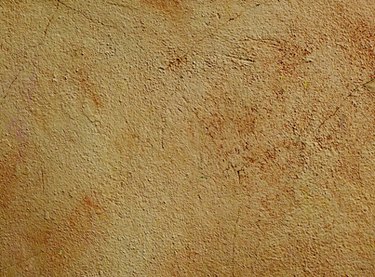Things You'll Need
White plaster powder, 1 lb.
Alkaline-resistant plaster pigment
Spoon
Measuring cup, 1/2 cup
Drop cloths
Painter’s tape
Paint tray
Liquid alkaline-resistant plaster tint
Paintbrush
Clean, dry rag (optional)

If you have a room with plaster walls or are about to cover a wall with plaster, you don't need to settle for stark white. You can tint your plaster to add some color to your project. Tint your dry plaster powder before applying it to your walls or other surface for an even appearance. You can also apply your pigment to already completed plaster walls for a mottled, faux aged appearance.
Tinting Before Application
Step 1
Spoon out the pigment carefully into your measuring cup. Don't ever pour the pigment out of its jar or bag, since the powder could spill or blow dust up into the air, causing a respiratory hazard. After you've measured the pigment, spoon it out of the measuring cup and directly into the white plaster powder bucket.
Video of the Day
Step 2
Spoon out a small amount of plaster powder into a bowl and mix it with a small amount of water to test out your plaster's tint. Add more pigment powder to the main bucket if you aren't satisfied with your tint's color.
Step 3
Mix your powder with water according to your plaster's label and apply it immediately to your surface.
Tinting Plaster Surfaces
Step 1
Open any windows, turn on fans and lay out your drop cloths to cover your floor and any other areas. Cover outlets and molding with painter's tape as necessary.
Step 2
Squeeze your liquid tint into a painter's tray and add water to get a murky, colored tone. Dip your brush into the tray, grabbing only a little tint; you don't need to saturate the brush. Apply tint to a hidden area on your plaster surface to test the color and then adjust water or pigment to your mixture as necessary.
Step 3
Apply the tint to the wall or other surface with your paintbrush. Create a distressed tint effect by dabbing a rag or dry brush over your still-wet work.
Tip
Use your plaster, mixed with pigment or otherwise, within a few months of purchase. While in storage, plaster absorbs moisture and gradually becomes unusable.
Warning
Plaster pigment is toxic. Do not ingest or inhale the powder. Wear a face mask when handling pigment powders.
Video of the Day